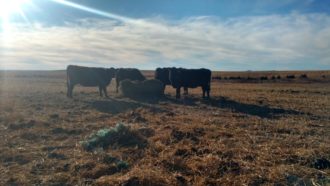What would you do with a depleted piece of land that was farmed without inputs and was no longer productive? When siblings Erin and Drew Gaugler faced a similar circumstance in North Dakota, they wondered, “Could bale grazing help?”
The Gauglers raise cattle and Erin is also a range research specialist at Central Grasslands Research Extension Center. To bale graze, producers typically leave baled hay in the field after cutting it so that cattle can graze on the bales throughout the winter. Producers monitor the cattle and hay supply, and the cattle’s access to bales is controlled using permanent and portable fencing.
“Research from multiple universities has shown that bale grazing can increase nutrient capture, cycling, carbon sequestration, and more,” says Erin, “but there is a lack of real-world application that combines all areas of focus and is readily available for producers to see the benefits and challenges of this winter feeding strategy.”
With support from a 2018 and a 2020 SARE Farmer Rancher grant, the Gauglers are exploring and documenting the impact of bale grazing on their farm. Their results have encouraged them to expand their areas of impact and renovate more hayland acres by bale grazing. They are sharing their results with area farmers through self-guided tours, field days, extension publications, and testimonials to help demystify bale grazing.
With outreach activities like their “mailbox tour,” where people can stop by on their own, grab a flyer, and take a look at the field, the Gauglers hope to help other producers in their area feel more comfortable with the idea of bale grazing.
“Folks in the local area have asked us several questions about what we are doing with the bales and they wonder how it works,” said Erin. “Drew and I have noticed that a handful of those same people have begun to implement bale grazing on their own operation.”
Dig Deeper
If you’re motivated to improve the health of your pasture, or are curious about bale grazing, check out ATTRA’s 20-page resource, “Nutrient Cycling in Pastures.”
Drew and Erin were featured on the Soil Sense podcast, talking about their bale grazing project and experience with NCR-SARE. Listen here.
Watch a video of the Gauglers presenting their research:
View Related SARE Grants:
- Bale Grazing to Build Soil Health (FNC18-1123)
- Multi-Species Bale Grazing to Build Soil Health (FNC20-1218)
